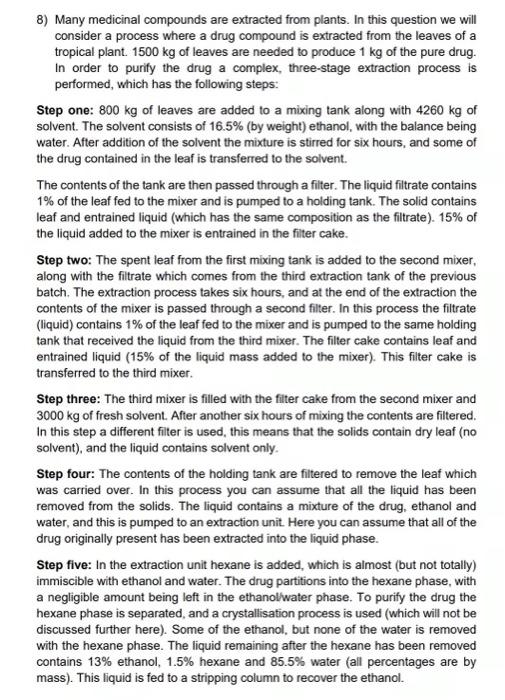8) Many medicinal compounds are extracted from plants. In this question we will consider a process where a drug compound is extracted from the leaves of a tropical plant. 1500 kg of leaves are needed to produce 1 kg of the pure drug. In order to purify the drug a complex, three-stage extraction process is performed, which has the following steps: Step one: 800 kg of leaves are added to a mixing tank along with 4260 kg of solvent. The solvent consists of 16.5% (by weight) ethanol, with the balance being water. After addition of the solvent the mixture is stirred for six hours, and some of the drug contained in the leaf is transferred to the solvent. The contents of the tank are then passed through a filter. The liquid filtrate contains 1% of the leaf fed to the mixer and is pumped to a holding tank. The solid contains leaf and entrained liquid (which has the same composition as the filtrate). 15% of the liquid added to the mixer is entrained in the filter cake. Step two: The spent leaf from the first mixing tank is added to the second mixer, along with the filtrate which comes from the third extraction tank of the previous batch. The extraction process takes six hours, and at the end of the extraction the contents of the mixer is passed through a second filter. In this process the filtrate (liquid) contains 1% of the leaf fed to the mixer and is pumped to the same holding tank that received the liquid from the third mixer. The filter cake contains leaf and entrained liquid (15% of the liquid mass added to the mixer). This filter cake is transferred to the third mixer. Step three: The third mixer is filled with the filter cake from the second mixer and 3000 kg of fresh solvent. After another six hours of mixing the contents are filtered. In this step a different filter is used this means that the solids contain dry leaf (no solvent), and the liquid contains solvent only. Step four: The contents of the holding tank are filtered to remove the leaf which was carried over. In this process you can assume that all the liquid has been removed from the solids. The liquid contains a mixture of the drug, ethanol and water, and this is pumped to an extraction unit. Here you can assume that all of the drug originally present has been extracted into the liquid phase. Step five: In the extraction unit hexane is added, which is almost (but not totally) immiscible with ethanol and water. The drug partitions into the hexane phase, with a negligible amount being left in the ethanol/water phase. To purify the drug the hexane phase is separated, and a crystallisation process is used (which will not be discussed further here). Some of the ethanol, but none of the water is removed with the hexane phase. The liquid remaining after the hexane has been removed contains 13% ethanol, 1.5% hexane and 85.5% water (all percentages are by mass). This liquid is fed to a stripping column to recover the ethanol. Step six: The feeds to the stripping column consist of the remaining liquid and steam. The overhead product contains 20% ethanol and 2.6% hexane, and the bottom stream contains 1.3% ethanol and the balance water. All percentages are by mass. Using this description of the process determine: a) The composition of the filtrate in the holding tank (give the mass of each component). b) The mass of the drug and ethanol leaving the extraction unit in the product stream, and the mass of each component in the stripper feed. c) The mass of steam fed to the stripping column and the percentage of ethanol recovered. [20 marks]








